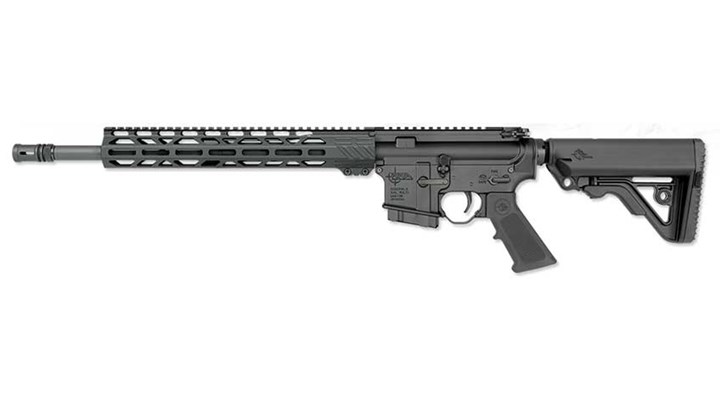Shooting Sports USA.
Armalite’s original blueprints specified a 20-inch barrel, 12-inch (measured from the upper-receiver face) gas-port location and a ballpark 12,500 PSI gas-port pressure level. Those are the “rifle” specifications, which work just fine. Therefore, the problem isn’t in the design. Rather, it’s in the redesign. The shorter the front end is, the more redesign has its influence. Carbine-length barrels and especially pistol-length barrels create a condition where using the same ammo there is higher gas pressure at the gas port.
An AR-15 has a “direct impingement” system. Propellant gas is bled off through a gas port in the barrel, this gas goes through the gas manifold or “gas block,” through a gas tube, and into the carrier key atop the bolt carrier, and that’s the end of the line—the resultant force deposited into the key starts the bolt-carrier assembly in motion.
Think of this gas system as a pressure chamber with two valves—one at the gas port and the other at the muzzle, and the moving bullet opens each valve as it crosses each plane. Therefore, the spacing of the valves matters greatly.
The better way to think of this is each is an orifice (even though an adjustable gas block is an adjustable orifice), not a valve.
As the bullet enters the barrel bore and moves forward, the space (volume) behind the bullet is increasing, which lowers the pressure of the contained gas behind it. More available barrel-bore volume before the gas port translates to lower pressure at the port. So, post-gas-port barrel length influences how long the system is “sealed” under full pressure, and the shorter the length, the shorter time. Again, the bullet is serving as a plug that’s sealing all the pressure in the system—until it exits.
[ … ]
Approximate figures for M855 (genuine 5.56 NATO) chamber pressure is about 60,000 PSI; pistol-location gas port pressure, 50,000; carbine-location, 33,000; mid-length, 27,000; rifle-location, 19,000. Thus, 5.56 NATO is hot and getting hotter, and it has been for years.
Installing a heavier buffer and also a stouter buffer spring buys time. Both increase resistance to the bolt unlocking, thus delaying it from moving. The heavier buffer better resists movement and moves slower. The stouter spring increases in-battery load against the bolt carrier, increasing its resistance to initial movement, and the carrier also then moves slower coming back against the buffer.
“Just put an adjustable gas block on it” is also routine advice, and, yes, that helps, but ideally such devices should be used to tune function. If it’s needed just to make the gun run, then the chances are certain something else was missed, most likely in the architecture. That’s where we’ll find the cure.
[ … ]
That’s easy enough with a carbine-length front, 16-inch barrel. A mid-length gas port is located 2 inches farther ahead of carbine-standard. It effectively also shortens the post-port distance by the same amount meaning lower pressure getting in and a shorter time the system is under maximum pressure. Both are good things.
If you’ve got a hankering for an AR-platform pistol, choosing a 10.5- or 11.5-inch barrel makes it possible to get a carbine-length gas system affixed, and that is a 3-inch additional length over the common 4-inch pistol-port, and a significant reduction in post-port length. That really tames a little gun.
I think it’s becoming fairly routine advice to choose the right gas system for your gun as a first step to correct over- or under-gassed systems, rather than tinkering with the gas block.
This is what the author is calling the “architectural” solution to the problem. This isn’t exactly the same thing as having an adjustable gas block on a new AR-10 6.5 Creedmoor with a fixed 20″ barrel for folks who want to shoot hotter loads or those who want to hand load specialized cartridges and need to make slight adjustments on the block to ensure reliable operation.




